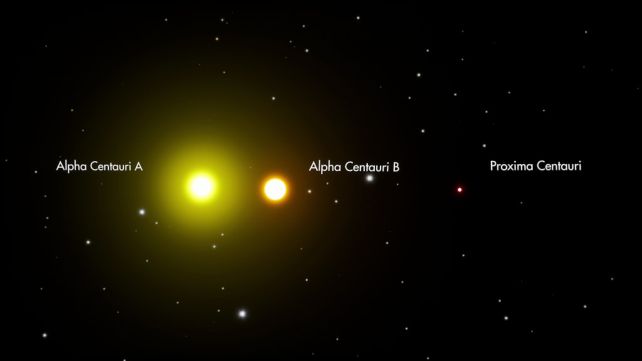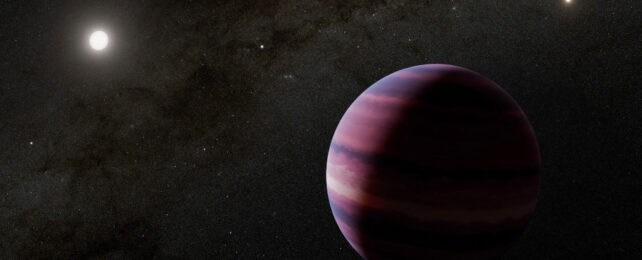There may be a habitable world at the Sun's closest solar twin.
In the complex space inhabited by the Alpha Centauri triple star system, JWST has just discerned the presence of a giant exoplanet orbiting Alpha Centauri A, the most Sun-like of the three stars.
Moreover, that exoplanet is in the star's habitable zone – the perfect distance from the star for liquid water to pool.
But wait – there's more. Evidence of the prospective world, which is tentatively known as Alpha Centauri Ab, was discovered using direct imaging in what could be a significant breakthrough for exoplanet science.
Related: We've Just Found an Exoplanet That's as Stinky as Uranus
"If confirmed, the potential planet seen in the Webb image of Alpha Centauri A would mark a new milestone for exoplanet imaging efforts," says astrophysicist Aniket Sanghi of the California Institute of Technology.
"Of all the directly imaged planets, this would be the closest to its star seen so far. It's also the most similar in temperature and age to the giant planets in our Solar System, and nearest to our home, Earth."
The Alpha Centauri system is located just 4 light-years away, a triple system made up of the binary pair Alpha Centauri A and Alpha Centauri B, orbited at a greater distance by the red dwarf star Proxima Centauri.

Other exoplanets are already known in the system. Three have been found orbiting Proxima Centauri, including one within the star's habitable zone. But the conditions around red dwarf stars – which tend towards the tempestuous – may be less hospitable than those around stars like the Sun.
The detection of worlds in the central binary has been more difficult to accomplish.
"With this system being so close to us, any exoplanets found would offer our best opportunity to collect data on planetary systems other than our own," says astronomer Charles Beichman, director of the NASA Exoplanet Science Institute at Caltech.
"Yet, these are incredibly challenging observations to make, even with the world's most powerful space telescope, because these stars are so bright, close, and move across the sky quickly."
To date, Alpha Centauri B remains without a known world. However, glimmers of something have been spotted in orbit around Alpha Centauri A, the brightest of the three stars and belonging to the same G-type class as the Sun.
In 2021, a team of astronomers led by Kevin Wagner of the University of Arizona announced a tentative detection of an exoplanet in the habitable zone of Alpha Centauri A, identified using direct imaging.
Most exoplanets are found using indirect methods, such as looking for regular dips in starlight, blocked by the orbiting exoplanet, or changes in starlight associated with the gravitational effect of the exoplanet's presence.

Sanghi, Beichman, and their colleagues used JWST to look for further evidence of this world, taking their first observations in August 2024, using a coronagraph to mask the light from Alpha Centauri A. After subtracting the light from Alpha Centauri B, their results showed a faint point source, at around twice the distance from Alpha Centauri as Earth is from the Sun.
But follow-up observations conducted in February and April of 2025 revealed no such object.
"We are faced with the case of a disappearing planet!" Sanghi explains. "To investigate this mystery, we used computer models to simulate millions of potential orbits, incorporating the knowledge gained when we saw the planet, as well as when we did not."
These simulations also included the sighting of Wagner and his team. In about half the simulations, the exoplanet was too close to the star to be detected, its presence drowned out by all the bright light – supporting the case for Alpha Centauri Ab.
This world, the researchers determined, would have a radius of around 1 to 1.1 Jupiters, a mass between 90 and 150 Earths, comparable to Saturn's 95-Earth mass, and orbit at about twice the Earth-Sun distance, squarely in the habitable zone.
This set of properties describes a world that would have to be a gas giant, which places its potential habitability into question. However, gas giants in the Solar System are lousy with moons that could have habitable conditions – so the nature of the exoplanet doesn't rule out life around Alpha Centauri A.
However, more work needs to be done to confirm the existence of Alpha Centauri Ab, and figure out how the heck it even formed in the complex gravitational environment of the Alpha Centauri system.
"Its very existence in a system of two closely separated stars would challenge our understanding of how planets form, survive, and evolve in chaotic environments," Sanghi says.
The finding is detailed in two papers in The Astrophysical Journal Letters. They can be found here and here.
